Discovering Dubai International City: A Detailed Guide
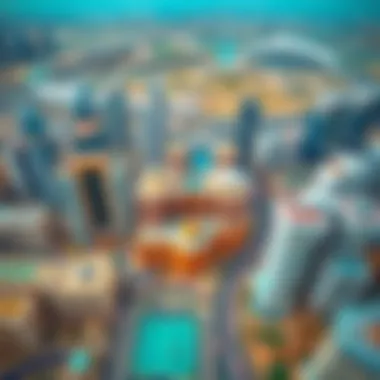

Intro
Dubai International City is more than just a neighborhood; it's a showcase of evolving architectural styles and cultural diversity. As a microcosm of global influences, this urban project pulls its inspiration from various countries, reflecting rich histories and traditions. Situated southeast of the city center, it stands amidst a backdrop of bustling developments in Dubai, making it an interesting case study for real estate investors and residents alike. The goal here is to provide a thorough understanding of what makes Dubai International City a noteworthy option in today's real estate landscape.
This comprehensive overview will touch on several vital aspects—from current market trends and pricing to the unique investment opportunities that arise in this eclectic locale. Furthermore, the article will highlight elements like the community's lifestyle, architectural flair, and future potential, offering valuable insights for anyone looking to dive into this vibrant market.
Market Trends
Current Real Estate Pricing
The current state of real estate pricing in Dubai International City can be likened to a fast-moving train. Prices are generally seen to be on the upswing lately, driven by increased demand from both local and international buyers. Recent figures indicate that apartments range from AED 300,000 to AED 800,000, showcasing the affordability compared to other neighborhoods in Dubai. The key here is to act quickly, as these prices may not hold steady in the face of rising demand.
Emerging Neighborhoods and Developments
With the city consistently evolving, new neighborhoods and developments are cropping up within Dubai International City. For instance, Cluster Z and Cluster W have become hotspots for those looking for reasonably priced accommodations. Both have modern amenities that cater to the needs of families, professionals, and expatriates. The influx of new shops, recreational facilities, and schools will likely make these areas even more appealing in the coming years.
"As the landscape continues to change, Dubai International City is fast on its way to becoming not just a residential hub but a community worth calling home." – Real Estate Analyst
Investment Opportunities
Short-Term vs Long-Term Investment Strategies
Investors often find themselves at a crossroads when it comes to making choices in Dubai International City. Whether one is eyeing short-term or long-term strategies can significantly impact financial outcomes. Short-term rentals cater well to expatriates, while long-term leases suit families seeking stability. Each investment path presents its own risks and rewards, demanding careful consideration before diving in.
Financing and Mortgage Options
Securing financing in Dubai can be a straightforward process with the right information. Various banks and financial institutions offer different mortgage plans, making it essential for potential buyers to shop around for options that best suit their needs. Local lenders often proffer attractive interest rates that can help expedite purchases. Additionally, many real estate agents are well-versed in the financing landscape, offering guidance tailored to international buyers and residents.
Ending
In summary, Dubai International City is a microcosm of growth and opportunity within the broader spectrum of Dubai's real estate market. With a mix of cultural influences, international flair, and affordable pricing, it remains a prime choice for various stakeholders. Whether you're an investor eyeing potential gains, a family looking for a comfortable home, or a renter in search of community, International City has something to offer. Understanding market trends and investment dynamics can be key to capitalizing on what this vibrant destination has in store.
Intro to Dubai International City
Dubai International City represents not just a place on the map, but an embodiment of a unique blend of culture, architecture, and investment opportunities in one of the world’s fastest-growing cities. Its significance in Dubai’s real estate market can't be overstated. As we dive deeper into this expansive development, it’s crucial to understand how it serves as a microcosm of Dubai's diversity and ambition.
Overview and Location
Located in the Al Awir area, Dubai International City sits to the east of the bustling centre of Dubai and is easily accessible from various major roads. It boasts a mix of residential, commercial, and recreational spaces spread across several themed zones inspired by various countries. This is not merely a residential area; it is a vibrant community that encapsulates global cultures in one locale.
The development occupies approximately 800 hectares, making it a sizable component of Dubai's real estate ecosystem. With its strategic positioning, it allows easy access not only to the city’s downtown but also to vital transport links, thereby offering potential residents and investors a compelling reason to consider this destination. Notably, it stands within proximity to academic institutions like the Academic City and the Dubai Silicon Oasis, further enhancing its appeal for families seeking education and employment opportunities.
Significance in Dubai's Real Estate Landscape
Dubai International City holds a pivotal position in the city’s real estate sector for several reasons. First, it serves as an affordable option for expatriates and families seeking budget-friendly living solutions, which is increasingly crucial given the soaring property prices in many parts of the city. This area offers a range of housing options, from studio apartments to larger family units, thus catering to a diverse market.
Moreover, it is noteworthy how Dubai International City has evolved since its inception into a multi-cultural housing enclave that reflects the global make-up of the city. It has become a home away from home for numerous nationalities, fostering a unique communal spirit. The socio-economic factors at play here—like price affordability coupled with a rich cultural tapestry—render this region an attractive proposition for both potential homeowners and tenants.
"Dubai International City is not just a residential area; it's an international community that embraces diversity while providing essential amenities and a lively neighborhood life.
Development History
The Development History of Dubai International City provides a fascinating glimpse into how visionary planning can reshape urban living. This background not only showcases the ambition behind the project, but it also illustrates the changes in real estate dynamics within Dubai. Understanding the history here is crucial, especially for investors and potential residents who are considering making this vibrant community their home. This section outlines the initial plans and the key milestones that crafted this unique locale.
Initial Plans and Vision
When Dubai International City was conceptualized, it aimed to reflect a global nexus, showcasing various cultural influences while providing affordable housing options. The initial vision was sparked back in the early 2000s, as part of Dubai's broader strategy to establish itself as a global metropolis. This development was to be more than just a residential space; it was meant to symbolize the melting pot of cultures found in Dubai.
The planners envisioned clusters representing different countries, each containing architectural styles and layouts reflecting its cultural heritage. This idea was to cater to the diverse expatriate population that has always formed a core part of Dubai's identity. The notion was that through international themes in architecture and urban design, residents could enjoy a slice of home away from home. Today's vibrant neighborhoods, such as China Town and Spain Cluster, stem from these initial plans, standing as testaments to successful multicultural integration.
Key Milestones in Development
The journey toward realizing Dubai International City has been marked by several significant milestones:
- Inception: The initial groundbreaking occurred in 2004, putting into motion an extensive plan that would cover over 800 hectares.
- First Phase Completion (2006): By 2006, the first residential units were completed and offered to buyers. This phase set the tone for future developments, illustrating the commitment to delivering quality homes at competitive prices.
- Expansion of Community Facilities: As the project progressed, more recreational facilities and amenities were introduced. By 2008, several parks, community centers, and basic infrastructure had been established, ensuring the project was not just about housing but also about fostering community spirit.
'The development of Dubai International City is a mirror of Dubai's rapid growth and vibrant diversity.'
- Economic Challenges: In the wake of the global financial crisis in 2008, there were hiccups in development. Some planned expansions were put on hold, but the vision remained steadfast. Resilience and adaptability became the core tenets that allowed Dubai International City to weather these challenges.
- Ongoing Revitalization: The governing bodies have continuously worked towards modernizing the infrastructure and improving facilities. Currently, investors can expect developments like enhanced public transportation links and upgraded community services.
Through these milestones, Dubai International City not only grew in physical dimensions but also underwent evolution in its role within the larger narrative of Dubai's real estate market. For investors and prospective residents, comprehending this development history adds vital context for making informed decisions about their involvement in the area.
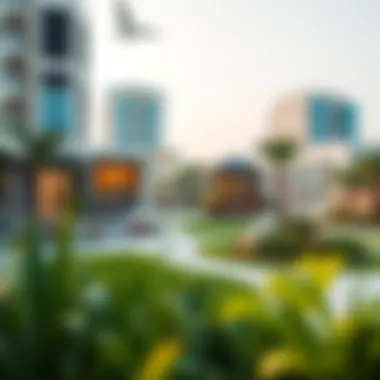
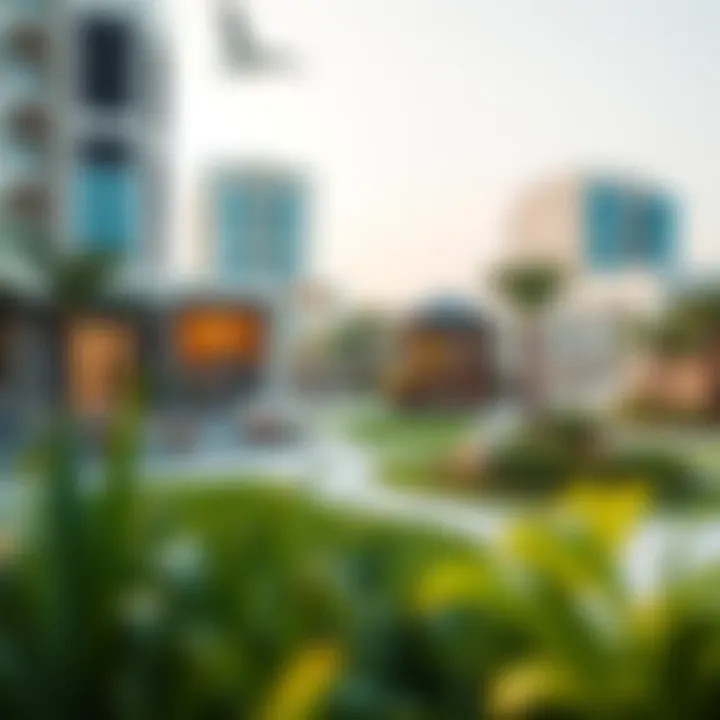
For more detailed insights into urban planning and development strategies, consider visiting
Wikipedia and Britannica.
Architectural Design
Architectural design plays a pivotal role in shaping the identity of Dubai International City. This development is not just a collection of buildings; it is a statement of cultural diversity and innovation. As a melting pot of various nationalities, the architectural styles reflect intricate themes that cater to a broad range of cultural narratives while fostering a sense of community.
The design elements are thoughtfully crafted to enhance the living experience. The layout of the space is functional yet aesthetically appealing, ensuring that each property enjoys enough light, ventilation, and privacy while still being part of a cohesive community. The emphasis on open green spaces and water features adds to the community feel, providing residents with places to relax and socialize.
Key Design Elements
When delving into the key design elements of Dubai International City, it’s essential to highlight several aspects:
- Building Materials: The properties utilize high-quality, sustainable materials that not only promise durability but also enhance the visual appeal.
- Architectural Styles: Different zones showcase distinct styles, from, modern designs to traditional forms, ensuring that various tastes are catered to.
- Landscaping: Thoughtful landscaping throughout the districts contributes to a serene atmosphere. Parks and green belts within the community encourage outdoor activities.
- Functionality: The interiors are optimized for comfort and utility, often featuring open-plan layouts that emphasize spaciousness.
These elements combine to create a harmonious living environment conducive to both families and expatriates, making Dubai International City a sought-after destination.
Influence of Cultural Themes
Cultural themes in the architectural design of Dubai International City provide a rich tapestry that tells the story of its diverse inhabitants. This is not merely an aesthetic choice, but a reflection of the intricate social fabric of Dubai.
The influence can be seen in various ways:
- Cultural Representation: Different clusters represent specific national heritages, evident through motifs and decorations based on those cultures. For instance, you might find architectural nods to Chinese pagodas or Spanish villas alongside contemporary Emirati designs.
- Community Spaces: Design choices prioritize communal areas that bring residents together, encouraging interaction and cultural exchange.
- Symbolic Features: Some buildings feature elements that symbolize peace and tolerance, reminding residents of the values that make Dubai a unique melting pot.
Rather than standing in isolation, the architecture of Dubai International City serves to connect its residents, promoting a sense of belonging across cultures. As one walks through the various neighborhoods, the architectural diversity becomes a living gallery of global cultures, making the area not just a residential hub, but a vibrant community that thrives on collaboration.
"Architecture should speak of its time and place, but yearn for timelessness." - Frank Gehry
In summary, the architectural design of Dubai International City encapsulates the essence of community and cultural diversity. From the choice of materials to the symbolic representations within the design, every aspect contributes to making this locale a special proposition for potential investors, homeowners, and renters alike.
Residential Options
When it comes to living in Dubai International City, the range of residential options plays a critical role. Understanding these choices can empower individuals, be they potential tenants, property investors or even expatriates considering a move, to make the best decisions. This section aims to explain the various residential opportunities available and their individual characteristics. It's not just about finding a roof over one’s head; it's about community, lifestyle, and investment potential.
Types of Properties Available
Dubai International City is a vibrant tapestry of different types of residences catering to a diverse population. Here are the primary property types you may encounter:
- Studio Apartments: These are compact and efficient, perfect for single professionals or students. Prices are reasonable, and the layout maximizes space, catering to minimalistic lifestyles.
- 1-Bedroom Apartments: A step up from studios, these units provide ample space for young couples or small families. The additional bedroom makes a significant difference in comfort.
- 2-Bedroom Apartments: Ideal for families or shared living options, two-bedroom apartments offer more room and accommodate various needs. They often come with larger living spaces, and the layout tends to be more functional.
- Villas and Townhouses: For those seeking a bit of luxury and space, villas offer gardens and more privacy. While they are on the higher end of the price spectrum, they often attract families who prioritize outdoor space for children.
- Commercial Spaces: Many residential units also double as commercial spaces in Dubai International City, catering specifically to entrepreneurs looking to run businesses close to home. This setup encourages a live-work lifestyle, common in urban areas.
Each type has its own unique charm and target demographic, creating an eclectic community that thrives on diversity. Choosing the right property can also impact social integration within the neighborhood.
Pricing Overview
Understanding the pricing structure is crucial for anyone considering a move to or investment in Dubai International City. Rent and property values here are generally more accessible compared to other areas in Dubai. Here's a quick breakdown:
- Studio Apartments: Typically range from AED 25,000 to AED 40,000 per year. These prices can fluctuate based on the age and condition of the building.
- 1-Bedroom Apartments: Expect to pay between AED 35,000 and AED 60,000 annually. Prices vary significantly according to location within International City.
- 2-Bedroom Apartments: Prices for these units generally sit between AED 50,000 and AED 80,000 annually, making them a more considerable investment but also more spacious.
- Villas and Townhouses: These are the priciest residential options, with annual rents commonly falling between AED 80,000 and AED 120,000, depending on the amenities offered.
For investors, these averages present intriguing opportunities. The rental yield in Dubai International City is notably higher compared to other districts. When you consider the ongoing development in public transport and community services, the potential for appreciation in property values looks promising.
"Investing in property here can lead to sustainable returns as the area continues to evolve and attract a cosmopolitan demographic."
Overall, when exploring residential options at Dubai International City, one discovers not just a place to live, but a potential gold mine of opportunities. As this community continues to grow, so do the possibilities for all residents.
Community Amenities
Community amenities are not just add-ons in a complex like Dubai International City; they're the lifeblood that connects the residents to a vibrant, engaging lifestyle. This eclectic development truly shines with its varied facilities, which cater to diverse needs and enhance the living experience. From leisure activities to retail options, these amenities are designed to create a sense of belonging and convenience for all its inhabitants.
Recreational Facilities
When it comes to recreational facilities, Dubai International City does not skimp on options. The vast landscapes are adorned with parks, jogging tracks, and sports courts. These spaces are not mere patches of greenery; they are social hubs where friendships sprout and families bond over weekend picnics. One of the standout features is the basketball and tennis courts that encourage residents to maintain a healthy lifestyle while also providing an avenue to unwind.
Another gem is the community swimming pool, which offers an oasis amidst the bustling lifestyle. Families often spend afternoons splashing about while adults engage in leisurely conversations by the poolside. This combination of physical activity and relaxation creates a balanced living environment. Residents often take this for granted, yet it's these little joys that enhance everyday living.
Moreover, kids' play areas are strategically located throughout the community, offering children safe spaces to explore their imaginative sides. With adequately equipped playgrounds, parents can take a breather while knowing their young ones are entertained and secure. This sort of integrated planning is what makes Dubai International City appealing to families and young professionals alike.
Retail and Dining Options
The shopping and dining scene within Dubai International City is as diverse as the residents themselves. Retail outlets are peppered throughout the community. From department stores to small boutiques, there’s something for every kind of shopper, catering to all tastes and preferences. Whether you're looking for the latest fashion trends or unique gifts, this area offers a variety that doesn’t disappoint.
Dining options are equally impressive. Residents can choose from international cuisine to local dishes without straying too far from home. Cozy cafes serve aromatic coffees perfect for a sunny morning, while family-friendly restaurants create an ideal atmosphere for gathering around a meal. Authentic Middle Eastern flavors are prevalent, comforting the souls of expatriates longing for a taste of home.
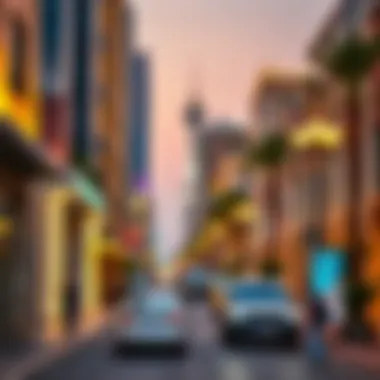
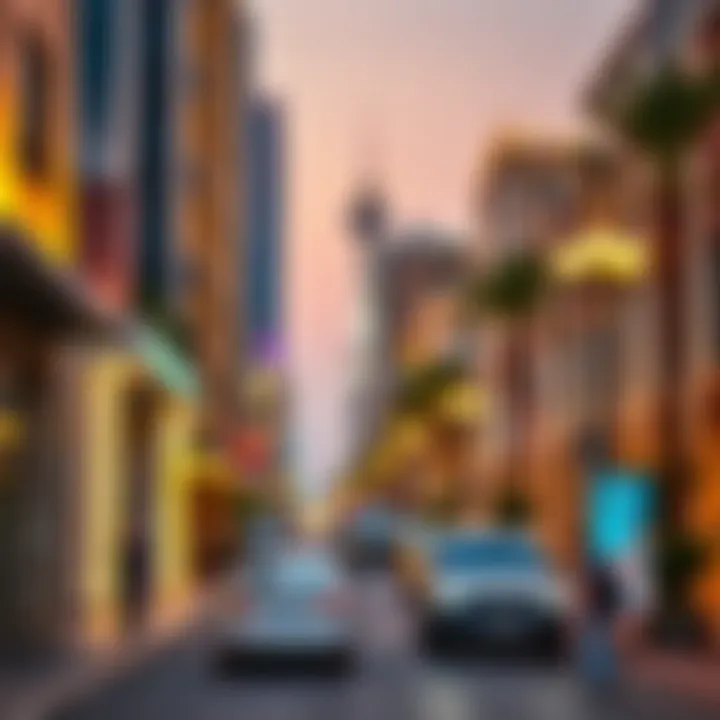
In addition to traditional dining, food trucks and pop-up stalls often set up shop, bringing in an array of casual eating options. These platforms promote community interaction and enjoyment—a perfect blend of flavors that encourages neighbors to mingle.
"Community amenities are more than just features; they are the fabric that weaves residents together, shaping not just a neighborhood but a true sense of belonging."
Lifestyle in Dubai International City
Dubai International City is more than just a collection of buildings; it encapsulates a way of life that attracts a diverse range of residents, from expatriates to entrepreneurs. The lifestyle in this unique region reflects the vibrancy and multicultural spirit of Dubai as a whole. It’s crucial for anyone considering a move or investment in this area to grasp how various factors contribute to the overall living experience.
Cultural Diversity and Integration
One of the standout features of Dubai International City is its cultural melting pot. This community is home to numerous nationalities, creating a lively atmosphere rich with various traditions and festivals. Residents often come together to celebrate cultural events, which include music, dance, and culinary fairs representing multiple backgrounds. This not only fosters a sense of belonging but also enriches the lifestyle of everyone in the area.
The presence of different cultures promotes integration, making it easier for newcomers to adapt to their new life. For instance, local markets sell products from various countries, while restaurants serve different cuisines, outfitting the community with an array of choices. This cultural fusion is a significant draw for many, particularly expatriates, who can find a piece of home, no matter where they're from.
Furthermore, the environment encourages intercultural dialogue, which can cultivate friendships across various backgrounds. Whether one is participating in a local event or simply striking up a conversation with a neighbor, there’s a palpable sense of camaraderie that makes daily life all the more enjoyable. This level of interaction plays a pivotal role not just in enriching personal experiences but also in fostering a supportive community where residents feel at home.
Community Engagement Activities
Community spirit thrives in Dubai International City, with numerous activities designed to engage residents and foster connections. Various clubs and societies offer platforms for people to gather based on common interests, whether that’s sports, art, or book clubs. Many residents participate in these activities, often turning casual acquaintances into lifelong friends.
Moreover, the city organizes regular community events aimed at uniting residents. Events such as weekend markets, outdoor movie nights, and fitness challenges not only provide entertainment but also create opportunities for networking among residents. For example, weekend fitness classes held in parks encourage a healthy lifestyle, while also serving as an avenue for social networking.
Another notable initiative is the community cleaner campaigns, where groups come together to beautify parks and recreational areas. This not only helps to maintain the environment but also instills a sense of ownership and pride among the community members, reinforcing the connection between residents and their living space.
In summary, the lifestyle in Dubai International City revolves around a rich tapestry of cultural interactions and community involvement. The integration of different cultures and robust community engagement activities contribute to a quality of life that is both rewarding and uniquely enriching. This blend of diversity and camaraderie solidifies Dubai International City’s appeal, making it not just a place to live, but a place to thrive.
Transport and Accessibility
Transport and accessibility play a vital role in shaping the appeal of Dubai International City. This large-scale development is not just a residential area, but a hub that connects seamlessly with various modes of transportation. Effective transport links can significantly influence property values, attract potential residents, and provide ease of lifestyle, which in turn strengthens the local economy. With the rapid growth of Dubai, understanding the transport systems available in and around International City is essential for investors and prospective residents alike.
Public Transport Options
In Dubai International City, public transport is designed to be both efficient and accessible. The backbone of the public transport system is the Dubai Metro, which has extended its reach to incorporate the needs of residents in this bustling development. The closest metro stations, such as the Al Qusais station, offer easy transfer to multiple areas of the city, providing residents with rapid access to key business districts, leisure facilities, and retail hubs.
Buses also play a significant role in public transit, with several routes connecting Dubai International City to the metro stations and other parts of Dubai. The services are regular and reliable, which makes commuting a breeze. The Roads and Transport Authority (RTA) has also made arrangements for the provision of taxis, which are available at relatively reasonable rates. This multimodal approach to public transport helps cater to different needs, ensuring that everyone has a way to get around.
- Key Public Transport Highlights:
- Dubai Metro proximity
- Multiple bus routes connecting the city
- Easily accessible taxi services
Connectivity to Key Areas in Dubai
Dubai International City is strategically located to ensure its connectivity to some of the most important areas in Dubai. The development is just a stone’s throw away from major highways, such as Sheikh Mohammed Bin Zayed Road and Al Refa'a Road, facilitating smooth commutes to places like Downtown Dubai, Dubai Marina, and other business districts.
"The connectivity of Dubai International City ensures that not only is it a residential zone, but also a gateway to the vibrant heart of Dubai.”
Another notable feature is the proximity to Dubai International Airport, which is around a 15-minute drive away, making it ideal for frequent travelers. This enhances the attractiveness of International City for expatriates who often travel for work. Additionally, close access to places like Dragon Mart, a major retail and wholesale hub, adds further convenience for residents.
- Connective Key Points:
- Direct access to Sheikh Mohammed Bin Zayed Road
- Proximity to Dubai International Airport
- Nearby major shopping and entertainment destinations
Investment Opportunities
Investing in Dubai International City presents a myriad of opportunities for both newcomers and seasoned investors. This area is characterized by its distinctive blend of cultural influences and modern amenities. With increasing developments and the ever-evolving market landscape, understanding the investment potential here is essential for anyone looking to make a mark in the real estate sector.
Market Trends and Forecast
The real estate market in Dubai International City has been witnessing notable changes recently. Factors contributing to this trend include favorable government policies, a robust economy, and a rising population that fuels demand for housing. Historical data indicates a steady price appreciation in this area, albeit with fluctuations tied to broader economic conditions.
In analyzing current market trends, key aspects include:
- Increased demand for affordable housing: As Dubai continues to expand, many are seeking budget-friendly living options, making Dubai International City an attractive prospect.
- Diverse rental market: The community's mix of cultures has led to a vibrant rental market, drawing in expatriates and families looking for a place to call home.
- Future developments: Further infrastructural projects and new amenities are planned, which are expected to positively influence property values in the coming years.
Experts forecast continued growth, with the potential for solid returns on property investment. An attentive investor recognizes the importance of monitoring these trends closely.
Potential Returns on Investment
When considering investments in Dubai International City, understanding potential returns is paramount. The area showcases a mix of residential, commercial, and mixed-use properties, offering diverse opportunities for profiting.
Advantages for investors include:


- Rental yields: Investors often find that rental yields in Dubai International City can reach impressive levels, often ranging between 7% to 10%. This is notably high, especially compared to other sectors within Dubai.
- Long-term appreciation: Properties here have shown consistent growth over the years, and with the anticipated future developments, investors can expect a significant rate of appreciation in property values.
- Regulatory support: The Dubai government has initiated several policies to support foreign investment, further enhancing the market's stability and attractiveness.
Nevertheless, investors should keep in mind that the property game can have its ups and downs. A detailed market analysis and careful investment strategy can mitigate risks, ensuring that you’re on the winning side of the equation.
"Investing in property requires not just cash, but also a sharp eye for potential and trends. Dubai International City holds untapped promise in both the residential and commercial aspects."
By navigating the intricacies of the investment landscape within Dubai International City, stakeholders can position themselves advantageously in a rapidly growing market.
Regulatory Aspects
Navigating the world of real estate investment in Dubai International City involves an understanding of several important regulatory aspects. These regulations not only govern the ownership and management of properties but also play a significant role in shaping the investment landscape in this vibrant locale. Familiarity with these laws can be instrumental for investors and potential homeowners, aiding them in making well-informed decisions.
Property Ownership Laws
In Dubai, property ownership laws are quite distinct. Foreigners can own property in designated freehold areas, which includes sections of Dubai International City. This has made the area increasingly attractive for expatriates seeking long-term investments or homes.
- Freehold vs Leasehold: In freehold areas, properties can be owned outright, while in leasehold areas, ownership is granted for a specified period, often 99 years. It's essential for potential buyers to understand which category applies to the specific property they are considering.
- Title Deed: Acquiring a title deed is a crucial step in property ownership. This document confirms ownership and is essential for any transaction, be it buying or selling.
- Regulatory Bodies: The Dubai Land Department oversees property ownership laws, ensuring all transactions comply with local regulations. Familiarizing oneself with this body can provide clarity on legal aspects.
Plainly put, understanding property ownership laws is like having the right map before embarking on a journey. It helps avoid potential legal pitfalls and ensures a smoother path to ownership.
Investor Guidelines
For those considering investment in Dubai International City, being well-versed in specific guidelines can significantly enhance the likelihood of success. Here are some crucial points to ponder:
- Residency and Visas: Investors purchasing properties worth a certain threshold (currently AED 1 million) may be eligible for a long-term residency visa. This can provide stability and encourage long-term investments.
- Due Diligence: Investors are advised to conduct thorough research before committing. This means understanding the property’s history, market value, and potential for appreciation. Knowledge is power in the investment arena.
- Engagement with Real Estate Professionals: Leveraging the expertise of local real estate agents or consultants can provide unique insights into the Dubai market. They can assist in navigating regulatory requirements and finding properties that match investment goals.
Investors ought to stay abreast of changing regulations that might influence their investment strategy. As with any financial venture, being informed and vigilant can help mitigate risks and enhance profitability.
Always remember, regulations often evolve, and keeping up with these changes is crucial for anyone keen on investing in Dubai International City.
Challenges and Considerations
In navigating the waters of real estate investing, especially in a dynamic locale like Dubai International City, understanding the associated challenges and considerations is paramount. While the region boasts myriad opportunities, it’s essential to grasp the intricacies that come with buying, renting, or investing in property. Consideration of these aspects can not only prevent potential missteps but also pave a smoother path towards successful investment.
Market Volatility Factors
Market volatility can be a double-edged sword; it offers both risks and rewards. In Dubai International City, fluctuations in property prices can be influenced by a myriad of factors, including economic conditions, legislative changes, and global events. For instance, when oil prices soar or plummet, it invariably affects expatriate populations and, subsequently, the demand for housing in Dubai. Investors should stay informed about these economic indicators, as they can significantly affect property values.
Additionally, trends in interest rates and inflation play a crucial role in the market landscape. For instance, if interest rates increase, borrowing costs rise, which can lead to decreased buying power for potential homeowners. Staying attuned to these trends can aid in making timely investment decisions.
Moreover, it’s worth noting that Dubai's real estate laws are constantly evolving, sometimes creating uncertainty. These regulations can impact property ownership, investment returns, and leasing agreements. Savvy investors often consult legal experts to navigate these waters effectively. Overall, it's wise to frequently reassess market conditions and adapt strategies accordingly to mitigate risks associated with volatility.
Community Issues
The fabric of any community is woven from its people and the environment they inhabit. In Dubai International City, where cultural diversity flourishes, certain community issues can arise. Understanding and addressing these is critical for fostering a desirable living environment.
One of the prevalent issues is the balance of cultural integration. With a melting pot of nationalities, tensions can sometimes mount. Community cohesion programs and activities aimed at promoting cultural exchange are crucial in bridging gaps among residents. Moreover, addressing the language barriers can enhance communication, thereby fostering a more inclusive atmosphere.
Another challenge is the infrastructure and maintenance of the area. As Dubai International City continues to develop, some residents have flagged concerns regarding the upkeep of public spaces and amenities. It's vital for the local authorities and community management to prioritize these concerns, ensuring that common areas are maintained and public services are accessible.
Lastly, safety and security remain pivotal. Although Dubai is known for its low crime rates, the rapid development can sometimes overshadow residential concerns. Residents must stay vigilant and actively participate in community safety initiatives, ensuring that everyone feels secure in their homes.
In summary, while Dubai International City presents promising opportunities, prospective investors and residents should weigh these challenges and community considerations carefully. Navigating such complexities often requires an informed approach and a willingness to engage with the community to foster a better living environment.
"In real estate, the duality of risk and reward is an ever-present reality; understanding both is key to navigating the market successfully."
For more in-depth insights, consider exploring resources such as Wikipedia or Britannica.
Closure
In wrapping up this exploration of Dubai International City, it becomes evident that this expansive community is not merely a residential area but a vital piece of Dubai's broader urban tapestry. The discussion throughout the article highlights various facets that make this locale a target of interest for various stakeholders, from investors eyeing profitable returns to families seeking a home amidst cultural diversity.
Summary of Key Points
As we draw our focus to the essential aspects discussed:
- Thriving Community: Dubai International City acts as a melting pot for over 200 nationalities, making it a unique place for expatriate families. The community spirit fosters a sense of belonging that attracts new residents year after year.
- Diverse Property Types: The range of housing options available caters to different budgets and lifestyle needs, from studios to multi-bedroom apartments. This variety enhances the area's appeal and accessibility.
- Robust Infrastructure: The strategic location with easy connectivity to public transport and main roads facilitates seamless travel to other parts of Dubai, further enhancing its desirability.
- Investment Potential: The real estate market here boasts favorable trends with promising returns, driven by the continuous demand for rental properties. Investors see Dubai International City as an attractive option in the ever-evolving property market.
The key takeaways illustrate how Dubai International City integrates lifestyle, investment opportunities, and community living cohesively, shaping the experience of its residents.
Future Outlook for Dubai International City
The outlook for Dubai International City appears bright as Dubai continues to expand and develop. With continuous improvements in infrastructure and community amenities, this area is poised to attract even more residents and investors. The Dubai government’s commitment to enhancing cultural and recreational facilities is expected to provide a further boost. Plans for new retail outlets and dining spots will only serve to enrich the community experience.
Moreover, as housing demands remain high in this thriving city, real estate prices are likely to reflect upward trends, making now a particularly opportune moment for potential buyers and investors. The local economy is set to prosper alongside the residential growth, ensuring that the vibrancy of Dubai International City will not only endure but likely flourish in the years to come.
This all paints a compelling picture for anyone considering a stake in this lively district, whether through living there or investing for profit.



